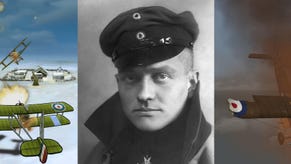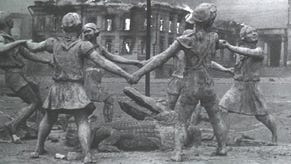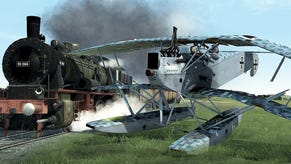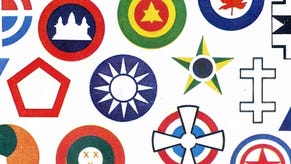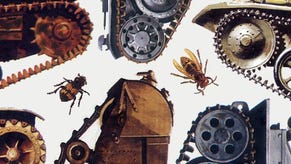The Flare Path: Iron Cross Edition
Simulation & wargame news
Usually a radio-controlled Zeppelin or the promise of a footplate ride on an elderly diesel loco, is enough to get a dev or publisher game coverage in the The Flare Path. This week however, bungs alone are insufficient. The three lovelies lionised south of the jump all earned their places through Sheer Merit. Well, Sheer Merit and a Shared Moniker, if you want to be pedantic. Meine Damen und Herren, I give you Iron Cross, Iron Cross, and Rise of Flight: The Iron Cross Edition.
I Was Monty's Doubles Partner
One of the only disadvantages of getting all your news off Radio 4 and the World Service is the lack of maps. Until yesterday I had no idea where in Libya Sirte was (Or indeed, how to spell it. That's another weakness of wireless). It took a sandy wargame from Zagreb to banish my ignorance.
Now all I need is a wargame from Sirte to show me where Zagreb is.
Iron Cross has been mentioned before on RPS. What hasn't been made clear is just how genre-proddingly revolutionary the thing is. A glance at screenshots and a cursory fumble with the free beta code tutorials suggests little unconventionality beyond the WW2 North African setting and the hexless battlefields. You have to dig around in the scenario folder and participate in one of the disappointingly infrequent MP sessions to see Iron Cross for what it really is – a breakthrough of Operation Supercharge proportions.
I've only managed to participate in one communal game thus far, and then I arrived late, and was allotted a very small command by my understandably cautious CO. Even so I left the field tipsy on IC's ambition and potential. At its most modest this is a game that lets two human generals spend an hour or two orchestrating a 48-hr, division-sized scrap for an amusingly named town (Fuka must fall!). At its most magnificent it's a game that allows up to 20 grognards to spend days seamlessly recreating huge hunks of the Desert War.
With its fine co-op facilities, 1000 mile-long campaign map, and scenarios spanning up to 90 days IC's capacity for writing grand Monty vs. Rommel narratives is, I suspect, unrivalled. My brief taste didn't give me much insight into how logistics, replacements or experience mechanics, impact longer scenarios, but it did leave me feeling like I'd just engineered a day of eminently plausible WW2 history.
It also confirmed a feeling that I'd got from the trio of SP scenarios that function as tutorials: Panzer Division have created a wonderfully lightweight GUI. IC's scope and realism might put it firmly in Anglo-German War 39-45 or War In The East territory but its idiotproof controls are far closer to Age of Empires or Company of Heroes. Units are generally battalion-sized and ordered about with three buttons (move, move sharpish, attack). Above heads and turrets, two status bars give instant feedback on crucial morale and efficiency levels. Efficiency? Where a less learned dev would have put hitpoint nibbling at the heart of battles, in IC the loss of effectiveness that comes from long hours in combat, is usually a far more pressing concern.

In what sounds like a very sensible move, the devs are currently working on a few single-player missions. Perhaps victories against robot Rommels will coax more grogs towards MP and one of the freshest, most interesting experiences PC wargaming presently offers.
Exhibit 31a
I wonder if Panzer Division realise that their creation isn't the 1st computer wargame to bear the name of Germany's most rust-prone gong. The original Iron Cross was fashioned by Phil 'HoMM' Steinmeyer in 1994 and is the sort of neglected trailblazer that Flare Path was invented to de-neglect.
Released a couple of years before Close Combat, Iron Cross sports crude forms of many of the groundbreaking features later popularised by Atomic's landmark series. Battles are turnless and, top-down. WW2 AFVs and infantry tussle over tracts of the West Front scattered with numerous types of tactics-impacting terrain. To have any hope of survival, stickmen soldiers must hug hedgerows, trot through through woodlands and wheatfields, and stay out of the long LoS/LoF corridors of mortars and MGs. Tanks aren't a great deal safer and must be withdrawn on occasions or turned so that tough frontal armour faces tormentors. It's not Steel Panthers or Combat Mission, but for a 1994 real-time effort, it's bold, realistic stuff.
Sadly, New World Computing's commitment to realism didn't quite extend to morale modelling, FoW, authentic penetration maths, or thorough unit research. One-shot kills aren't possible, and moving from the beaches into the bocage the Allied player can expect to encounter a surprising number of improbably ferocious exotics. Losing Shermans to Schleppers and Maultiers isn't unheard of.
And yet, even with deadly halftracks, fidgeting AT guns, and infantry squads chockablock with flamethrowers and bazookas thanks to dodgy pre-battle unit pricing, IC still manages to display many of the same qualities that made Close Combat and its successors such potent war-story factories. The AI is just unpredictable enough to ensure ambushes are tense. Vanquishing a particularly stubborn Tiger tank stirs the blood pretty effectively, as does watching tiny Typhies skim treetops enroute to drop bombs. In my last session two enemy squads were wiped out by a dynamic brushfire kindled by one of my artillery stonks. Totally realistic? Probably not. Evidence - along with all those other CC-esque characteristics - that Iron Cross deserves its own alcove in the Museum of Wargaming I'm currently building on a perfectly hexagonal hill near Villers-Bocage? I reckon so.
The Fokker Splurge (Part I)
I've been away from constantly-evolving Great War flight sim Rise of Flight for so long that when, earlier this week, I finally got round to returning, I wasn't quite sure whether to salute it, shake its hand, or give it a lingering hug.
In the end I opted to combine time with one of the new (to me) payware aircraft, with a taste of one of the most exciting features added since release. I decided to commence My Very First RoF Career.
On September 1st, 1916, three rather exciting things happen to a “cold and disciplined” 25-year-old labourer from Nuremberg. He joins the Luftstreitkräfte - Jasta 2 to be precise. He's assigned a brand new Fokker Eindecker. And, perhaps most exciting of all, he becomes the latest in a long line of German airmen to bear a name-that-actually-seemed-quite-funny-when-I-first-used-it-in-RB-back-in-the-early-Nineties. The man previously known as “You there!” or “Thingumeejig” becomes 'Gunther Ground'.
Shortly after his christening Gunther also gets a visage. It's a hard decision but in the end I put 'sensible attire' before 'brooding good looks' or 'my hobbies include fencing and heel-clicking'.
Do Gunther's more soberly named and, almost certainly, posher squadron-mates tease him on his arrival at Venu aerodrome (In your face Collins Dictionary!)? Do they make him strip down to his patched underpants and drain a shell-case full of schnapps while being pelted with chicken feathers? RoF refuses to say. It's much more interested in getting the new recruit airborne. The day after G unpacks his battered cardboard suitcase, and pins up a photograph of his favourite wheelbarrow next to his bunk, the young flier finds himself sitting in the beautifully modelled cockpit of a Fokker monoplane about to embark on an 'Offensive Patrol' with comrades Dietrich and Herman.
Mercifully, D & H are too busy with their own starting procedures to notice the nervous newcomer speculatively pressing 'I', 'E', 'S' and then 'I' again (Time with the tutorials prior to signing-up probably would have been wise). Eventually all the jabbing pays off, and the elegant air-oar on the prow of the plane begins churning. Sixty seconds later a white-knuckled Gunther is glancing over his shoulder at shrinking hangars and wondering how he could have forgotten about the Eindecker's primitive speed controls and disconcerting lack of ailerons.
To slow this fledgling warbird down the throttle must be blipped or the fuel mixture adjusted. To persuade it to roll the pilot must utilize a system of horrifically inefficient wing-warping cables. Gunther starts wondering whether he should have stuck to labouring. Maybe it wasn't too late to get a transfer to the Zeppelin corps. His brother said they were always looking for sharp-eyed... SCHEISSE!!
After almost colliding with an observation Drachen, G resolves to concentrate on the job at hand. Streaking Crawling west towards the brown stripe of savagery that is The Front, it isn't long before he finds himself looking down on the unmistakeable outline of an Airco DH.2. The Brit is low and pottering about like a bored box-kite. G can't resist. Scenting glory, he gestures frantically to his distant comrades (who ignore him) then heaves his machine into a steep dive.
The sound of wind whistling over wire grows louder as his grip on the stick tightens. The Eindecker feels lumpen – surly - but G's wiry labourer's arms keep it in line. Down he goes. Down and down. If the panicking Airco pilot chose to look up at this moment he'd see a plunging Angel of Death. He'd see a man soon to be hailed as 'a natural' by smiling mess-room comrades. He'd see...
...a plane without a vertical stabilizer spiralling towards oblivion?
KNICKERS.
Does Gunther survive his self-inflicted death dive? Does he return to Nuremberg and marry his childhood-wheelbarrow? Find out next week*
*by which time I should have flown the tutorials, read the wiki, got some practise in, and be far less likely to make a complete tit of myself.


















